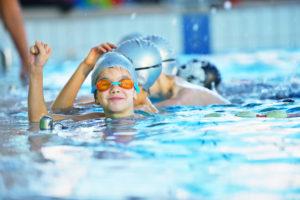Accelerate your child’s swim skills with these supplemental activities
Just like any sport, getting better requires a little extra work. For young athletes, these extra activities can create a solid foundation which will cause them to get much better much faster as they get older. But swimming poses a unique challenge because not everybody has constant access to a pool to train swimming skills. Here are three easy things parents can do to improve children’s swim skills.
Eat healthy
Swimming is one of the most calorie-intense sports because of the amount of resistance movement required. Traditionally, most non-swimmers have looked at swimmers with a false understanding that eating just any calories is a good thing. I’m here to tell you that is not the case.
Swimming is just like any sport that the proper amount of calories is key. High protein, low saturated fats, and lots of carbs are typically the best. Plenty of pre-packaged foods are available to help achieve these goals, but fresh, homemade food is the best. An article created by Fitter and Faster recommends peanut butter, milk, yogurt, and eggs as some of the best post-workout foods.
Good nutrition is vital because it allows swimmers to recover faster and build strength quickly. For parents looking to improve children’s swim skills, a good diet from the start can be the tipping point to turn you into a state champion.
Sleep well
In the age of tech, children are staying up later and later than ever before. While there are benefits to staying up slightly later, the vast majority of children fail to make up the lost sleep. According to sleep.org, children between the age of six and twelve should be getting between nine and twelve hours of sleep each night.
Along the same lines as healthy nutrition, swimming is a high intensity sport so it is important athletes get the proper amount of rest to fully recover for their next practice. For summer swim teams, it is very easy to get lost with how late children stay up and how tired they really are from the day’s activities. A simple thing like sleep can go a long way in helping develop your child’s swim skills.
Stretch
Stretching is something often overlooked by coaches and parents when it comes to young athletes. After all, you can practically drop a child off a cliff and they’ll bounce off the ground. But, the elementary school aged child is just starting to really take off in their growth so it’s important their muscles keep up with this growth.
Forgetting to stretch can cause muscles to be very tight. And although they may not cause discomfort to the swimmer, those tight muscles definitely can hinder improvement. Tight hamstrings and tight hip flexors can create a less powerful kick, tight triceps can create a shorter pull, and tight shoulders can limit the power of your stroke. These may not be immediately obvious in your child right now, but we want to do everything we can to get them ahead of their competition so they can improve their swim skills quickly.
Simple stretches such as a hamstring stretch, tricep and arm stretches, and simple yoga poses like downward dog and child’s pose can really relax the muscles in a child. As they grow, their muscles can easily catch up with their bodies.
Bonus: run
Running is such a great way to build lung capacity and muscle endurance because of the intensity that athletes must train at. Running requires athletes to inhale and exhale rapidly and with great force that it builds the lung capacity swimmers to desperately need.
For children, this doesn’t have to be going for a scheduled run around a certain route. It could just mean playing kickball outside with some friends or basketball in the winter. Any activity with running will help your child build lung capacity causing them to improve faster in the water.
The only thing that can improve swimmer’s skills is actually swimming. But you can help improve your child’s swim skills by encouraging them to eat healthy, to sleep well, and to stretch. These little things will help them build a solid foundation early in their lives so they can be in the position to improve as they continue to develop.

